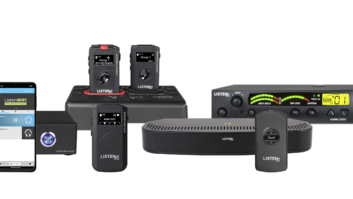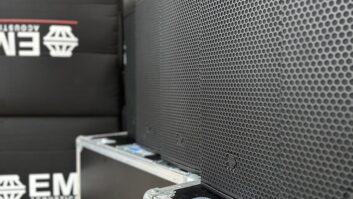 The events of early 2020 ushered in an era in which touch-free AV interactivity was transformed from being a convenient feature of modern technology into a critical tool in the battle to maintain public health and safety amidst a global pandemic. As a result, in the past 18 months our team has seen a dramatic rise in demand for our touchless Audio Spotlight focused sound technology, which creates a tight, narrow beam of sound that can be controlled with the same precision as a flashlight.
The events of early 2020 ushered in an era in which touch-free AV interactivity was transformed from being a convenient feature of modern technology into a critical tool in the battle to maintain public health and safety amidst a global pandemic. As a result, in the past 18 months our team has seen a dramatic rise in demand for our touchless Audio Spotlight focused sound technology, which creates a tight, narrow beam of sound that can be controlled with the same precision as a flashlight.
SOCIAL CHANGE
Faced with the changed social landscape brought on by the pandemic, museum and gallery directors and other property managers are rethinking exhibit designs and audio delivery systems to ensure
the safety of patrons as well as staff members. Venue owners are keenly aware that simply cleaning hand-held devices with anti-bacterial or anti-viral products does not guarantee that an
item has been adequately sanitised and neither frequent nor periodic treatment is considered practical or safe when hundreds or thousands of guests interact with such devices daily. As a result, focused sound has become a valuable tool in the battle against the spread of Covid-19 owing to its inherently touchless design that delivers personalised audio experiences without requiring any physical contact by the listener.
We’ve worked closely with museum and gallery personnel and other business owners to implement motion-activated directional sound technology to replace unsanitary hand-held audio devices. By eliminating the need for exhibit patrons to use tactile devices such as headphones, handsets, and listening wands, touchless audio technology has played a key role to promote guest safety and social distancing since the start of the Covid-19 pandemic.
In today’s environment, if a patron knows that they will need to use a hand-held device as part of a gallery or exhibit tour, they’re less likely to patronise a venue that utilises systems that are not hands-free. This not only affects the traffic, revenue, and success of the venue itself, but the livelihood of the community in which it resides, as well as the trajectory of an entire industry of curated collections.
Prior to the outbreak of Covid, people were accustomed to gathering in tightly packed groups and very few ever thought twice about being in close proximity to dozens, hundreds, or even thousands of other people. In the absence of instructions posted at venue entrances, standalone or wall-mounted signage that can be overlooked, directional speaker technology provides an effective, unobtrusive solution to help people practice and maintain safe social distancing.
Designers and facility managers who use focused sound technology can add audio sources at specific positions that are strategically spaced within a venue to encourage social distancing simply by placing directional sound beams in a way that creates listening experiences at intentionally safe (2m+) distances apart from each other.
For example, in museums, multiple directional speakers could be placed in two metre intervals, or wider if necessary, to inherently encourage proper spacing between patrons who are engaging with exhibits. This type of arrangement is often enhanced with floor decals to add a visual element, and effectively guide them to the otherwise unsuspected focused audio experience.
PUBLIC SAFETY
In addition to museums and galleries, focused sound technology has been implemented to enhance public safety in a range of other venues and applications including libraries, hospitals, command centes, control rooms, and TSA checkpoints in airports, as well as digital signage, retail displays, and OOH advertising.
In these settings and applications, directional speakers provide isolated audio that captivates listeners with an immersive, touchless personal experience, while keeping the surrounding area quiet. Particularly over the past two years, its implementation allows venue owners to continue operations, or even to reopen for guests who want to safely reestablish their patronage.
At a recent exhibit in Germany, the museum’s managing director told us that there were going to be more than two dozen separate stations with sound, grouped very closely together, and headphones were not going to be used because they would have created a sanitary concern and disrupted the exhibition’s overall appearance. Still, they needed to provide separate audio at each of 25 key exhibits, all in close proximity. As a result, the event’s interior designer sought to implement a technical solution that was just as complete, while being as invisible and effortless as possible, which made our technology the ideal solution.
Another early identifying customer of the inherent touchless benefits of directional speakers was a pediatric dentistry office in the United States. For years, their child patients were issued Bluetooth headphones to keep them entertained and distracted through dental procedures, and just as the pandemic was setting in, the facility elected to replace those headsets with ceiling mounted Audio Spotlight speakers instead, beaming the sound down to their heads precisely, for just as personal a listening experience, with zero transmission of germs from their audio equipment.
What makes the Audio Spotlight so versatile is that it’s a single plug-and-play device, and is compatible with virtually any existing audio feed. It features a built-in amplifier/processor, microSD card reader for direct playback via preloaded media, and we even have a motion sensor/trigger option that can be embedded right into the face of the speaker panel, so that when a listener enters the narrow beam, the sound automatically plays.
FUTURE EVOLUTION
While directional speakers have long been appreciated as a natural upgrade over traditional tactile methods like headphones, handsets, and listening wands, the pandemic has effectively pushed the evolution of personalised listening forward, effectively rendering those antiquated alternatives obsolete.
As designers and venue owners continue to strategise and refine their approach to human interactivity in light of Covid-19, we anticipate that the demand for innovative touchless AV products will continue to rise. We also expect that the impact the pandemic has had throughout the world will have a lasting – if not lifelong – impact on most people in terms of living their lives in the most ‘touchless’ way possible.
This is a very exciting time as we find ourselves thrust into a setting in which our technology is not only delivering a uniquely engaging and immersive directional sound capability, it is also helping to ensure the safety and health of those who are listening to it.







